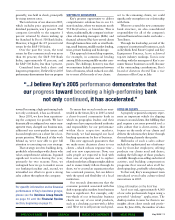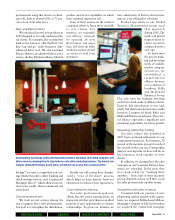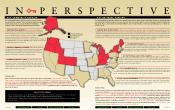KeyBank 2005 Annual Report Download - page 15
Download and view the complete annual report
Please find page 15 of the 2005 KeyBank annual report below. You can navigate through the pages in the report by either clicking on the pages listed below, or by using the keyword search tool below to find specific information within the annual report.
14
MANAGEMENT’S DISCUSSION & ANALYSIS OF FINANCIAL CONDITION & RESULTS OF OPERATIONS KEYCORP AND SUBSIDIARIES
Corporate strategy
Our strategy for achieving Key’s long-term goals includes the following
five primary elements:
•Focus on our core businesses. We concentrate on businesses that
enable us to build relationships with our clients. We focus on our
“footprint” operations (i.e., those businesses conducted primarily
within the states in which we have KeyCenters) that serve individuals,
small businesses and middle market companies. In addition, we
focus nationwide on businesses such as commercial real estate lending,
investment management and equipment leasing. We believe we
possess resources of the scale necessary to compete nationally in the
market for these services.
•Build relationships. We work to deepen our relationships with
existing clients and to build relationships with new clients, particularly
those that have the potential to purchase multiple products and
services or to generate repeat business. To that end, we emphasize
deposit growth across all our lines of business. We also are putting
considerable effort into enhancing our service quality.
•Enhance our business. We strive for continuous improvement in
our businesses. We continue to focus on increasing revenues,
controlling expenses and maintaining the credit quality of our loan
portfolios. We will continue to leverage technology to reduce costs and
to achieve these objectives.
•Cultivate a workforce that demonstrates Key’s values and works
together for a common purpose. Key intends to achieve this by:
— paying for performance if achieved in ways that are consistent with
Key’s values;
— attracting, developing and retaining a quality, high-performing and
inclusive workforce;
— developing leadership at all staff and management levels; and
— creating a positive, stimulating and entrepreneurial work environment.
•Enhance performance measurement. We will continue to refine and
to rely upon performance measurement mechanisms that help us
ensure that we are maximizing returns for our shareholders, that those
returns are appropriate considering the inherent levels of risk involved
and that our incentive compensation plans are commensurate with the
contributions employees make to profitability.
Economic overview
In 2005, U.S. economic growth was very healthy as measured by the
Gross Domestic Product (“GDP”). GDP growth remained above 3.3%
during the first three quarters of 2005, marking ten straight quarters
above that level. The nation’s unemployment rate averaged 5% during
the year, while the economy created an average of 165,000 new jobs per
month. New and existing home sales reached record levels in mid-
2005, but showed signs of slowing toward the end of the year. Rising
energy prices, which were exacerbated by hurricanes Rita and Katrina,
served to at least temporarily increase a variety of inflation measures
to the upper end of the FRB’s expected range. Crude oil prices rose
approximately 45% during 2005. Despite higher energy costs, personal
spending remained robust as consumers continued to borrow against
rising real estate values. In an effort to keep inflation from escalating, the
Federal Reserve raised the federal funds target rate from 2.25% to
4.25%, gradually over the course of the year. Core consumer inflation
rose at a 2.2% rate, matching the 2004 level. In addition, continued
domestic and foreign investor demand for high quality Treasury bonds
served to keep long-term interest rates low, resulting in a relatively flat
yield curve. The benchmark 10-year Treasury yield began 2005 trading
at 4.21% and finished the year at 4.39%. The 2-year Treasury yield
began 2005 at 3.10%, but closed the year at 4.41%. During 2005, the
banking sector, including Key, experienced modest commercial and
mortgage loan growth.
Critical accounting policies and estimates
Key’s business is dynamic and complex. Consequently, management
must exercise judgment in choosing and applying accounting policies
and methodologies in many areas. These choices are important: not only
are they necessary to comply with GAAP, they also reflect management’s
view of the most appropriate manner in which to record and report
Key’s overall financial performance. All accounting policies are
important, and all policies described in Note 1 (“Summary of Significant
Accounting Policies”), which begins on page 57, should be reviewed for
a greater understanding of how Key’s financial performance is recorded
and reported.
In management’s opinion, some accounting policies are more likely
than others to have a significant effect on Key’s financial results and to
expose those results to potentially greater volatility. These policies
apply to areas of relatively greater business importance or require
management to make assumptions and estimates that affect amounts
reported in the financial statements. Because these assumptions and
estimates are based on current circumstances, they may change over time
or prove to be inaccurate. Key relies heavily on the use of assumptions
and estimates in a number of important areas, including accounting for
the allowance for loan losses; loan securitizations; contingent liabilities,
guarantees and income taxes; principal investments; goodwill; and
pension and other postretirement obligations. A brief discussion of
each of these areas follows.
Allowance for loan losses. The loan portfolio is the largest category of
assets on Key’s balance sheet. Management determines probable losses
inherent in Key’s loan portfolio and establishes an allowance that is
sufficient to absorb those losses by considering factors including
historical loss rates, expected cash flows and estimated collateral values.
In assessing these factors, management benefits from a lengthy
organizational history and experience with credit decisions and related
outcomes. Nonetheless, if management’s underlying assumptions later
prove to be inaccurate, the allowance for loan losses would have to be
adjusted, possibly having an adverse effect on Key’s results of operations.
Management estimates the appropriate level of Key’s allowance for
loan losses by separately evaluating impaired and nonimpaired loans.
An impaired loan is allocated an allowance by applying an assumed
rate of loss to the outstanding balance based on the credit rating
assigned to the loan. If the outstanding balance is greater than $2.5
million, and the resulting allocation is deemed insufficient to cover the
extent of the impairment, a specific allowance is assigned to the loan. A
specific allowance may also be assigned even when sources of repayment
appear sufficient, if management remains uncertain about whether the
loan will be repaid in full. The methodology used to assign an allowance
NEXT PAGEPREVIOUS PAGE SEARCH BACK TO CONTENTS
























